In a world where efficiency often trumps tradition, virtual assistants (VAs) have become more than just a remote workforce trend; they’ve become indispensable to modern business operations. From solopreneurs managing their inboxes to Fortune 500 teams offloading project coordination, the VA industry has exploded in demand and diversity. And as we step into 2025, the data tells a compelling story of how deeply integrated these digital professionals have become in every sector imaginable.
Editor’s Choice
- $28.7 billion is the estimated global market value of virtual assistant services in 2025, showcasing an accelerated growth trajectory.
- 41% of all U.S. small businesses now work with at least one virtual assistant in 2025.
- The freelance VA workforce has grown by 19% year-over-year, driven by remote work normalization.
- In 2025, administrative support remains the most outsourced VA task, accounting for 34% of all delegated assignments.
- The average hourly rate for U.S.-based VAs hit $38.60 in 2025, marking a steady increase in the value of specialized skills.
- 72% of businesses report cost efficiency as their main reason for hiring virtual assistants in 2025.
- 36% of VAs now offer AI tool integration services, reflecting a strong shift toward tech-enabled productivity in 2025.
How Virtual Assistants Learned Their Skills
- 41% of virtual assistants already had the skills before entering the VA profession, indicating prior experience or transferable knowledge.
- 28% learned through paid training, showing a strong investment in formal education to build their VA capabilities.
- 23% relied on free resources or were self-taught, highlighting the accessibility of online learning for aspiring VAs.
- 8% gained skills through on-the-job training, reflecting a learn-as-you-go approach within actual work environments.
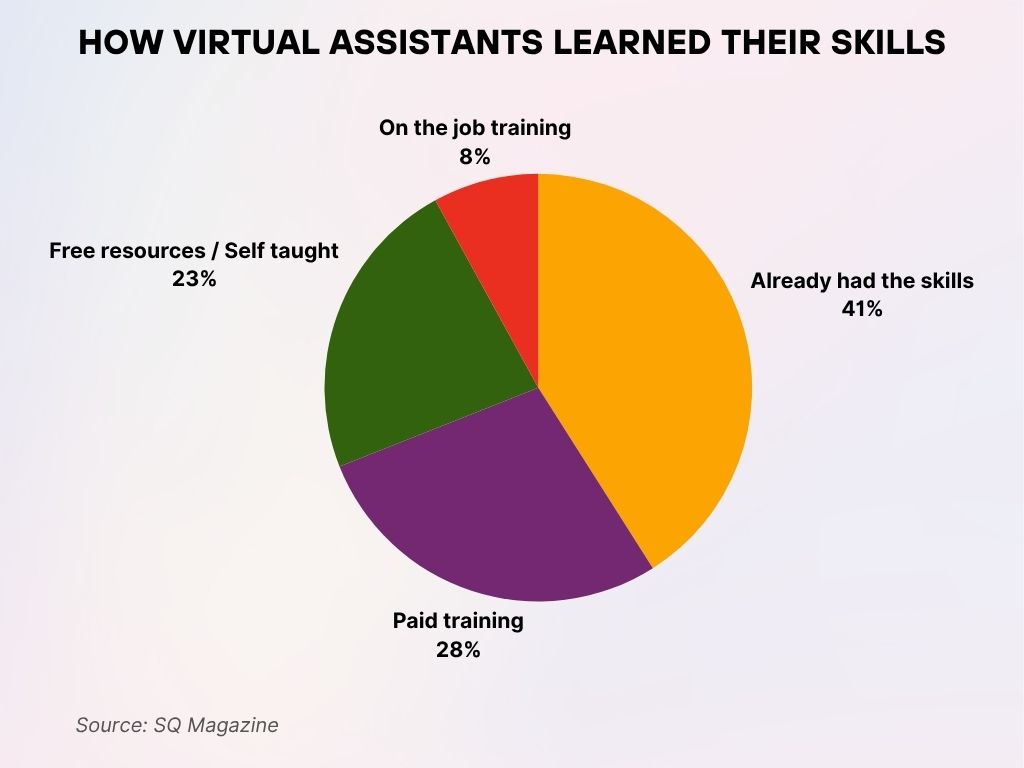
Key Demographics of Virtual Assistants
- In 2025, 74% of VAs worldwide identify as female, with a rising number of male professionals entering the field.
- The average age of a VA in 2025 is 34 years old, with 46% falling between ages 25–35.
- 62% of VAs hold at least a bachelor’s degree, and 17% have a postgraduate degree in 2025.
- Digital nomads now make up 21% of the VA workforce globally in 2025.
- 72% of VAs in 2025 work from home full-time, while 19% work from co-working spaces.
- The Philippines, known for VA talent, hosts over 1.3 million active VAs in 2025, making it the largest single-country VA workforce.
- In the U.S., California, Texas, and Florida lead in domestic VA registrations as of 2025.
- 89% of VAs speak at least two languages, contributing to their demand for cross-border business tasks in 2025.
- 67% of VAs market themselves on freelance marketplaces, while 24% rely on long-term agency placements.
- Veterans and career changers made up 11% of new VAs entering the industry in 2025, reflecting broader workforce shifts.
Remote Work and Virtual Assistants
- 84% of virtual assistants work fully remotely in 2025, reflecting the maturity of distributed work models.
- 49% of remote teams globally include at least one VA by 2025, often embedded across multiple departments.
- The average number of weekly hours worked by a VA in 2025 is 33.4 hours.
- 62% of VAs report working across multiple time zones, supporting businesses on a follow-the-sun model in 2025.
- In 2025, 27% of VAs describe their roles as “hybrid,” combining live communication with asynchronous task delivery.
- 91% of companies hiring VAs in 2025 do so via fully virtual onboarding and project management tools.
- Asana, Slack, and Trello remain the top three tools used by VAs to manage tasks and communications in 2025.
- Cybersecurity protocols for remote VAs have been adopted by 72% of companies in 2025.
- 35% of virtual assistants report working with clients across three or more continents in 2025.
- Work-from-anywhere arrangements are the new norm, with 53% of VAs working while traveling part-time in 2025.
Top Reasons Business Owners Outsource to Virtual Assistants
- 37.7% outsource for increased efficiency, making it the top reason among business owners.
- 20.5% want to free up in-house employees so they can focus on other critical tasks.
- 14% aim to reduce operating costs, highlighting the financial advantage of hiring VAs.
- 9.7% do it to increase available resources, allowing businesses to scale operations smoothly.
- 6.3% value increased flexibility, using VAs to adapt quickly to changing workloads.
- 4.3% want assistance from experts, relying on the specialized skills VAs can offer.
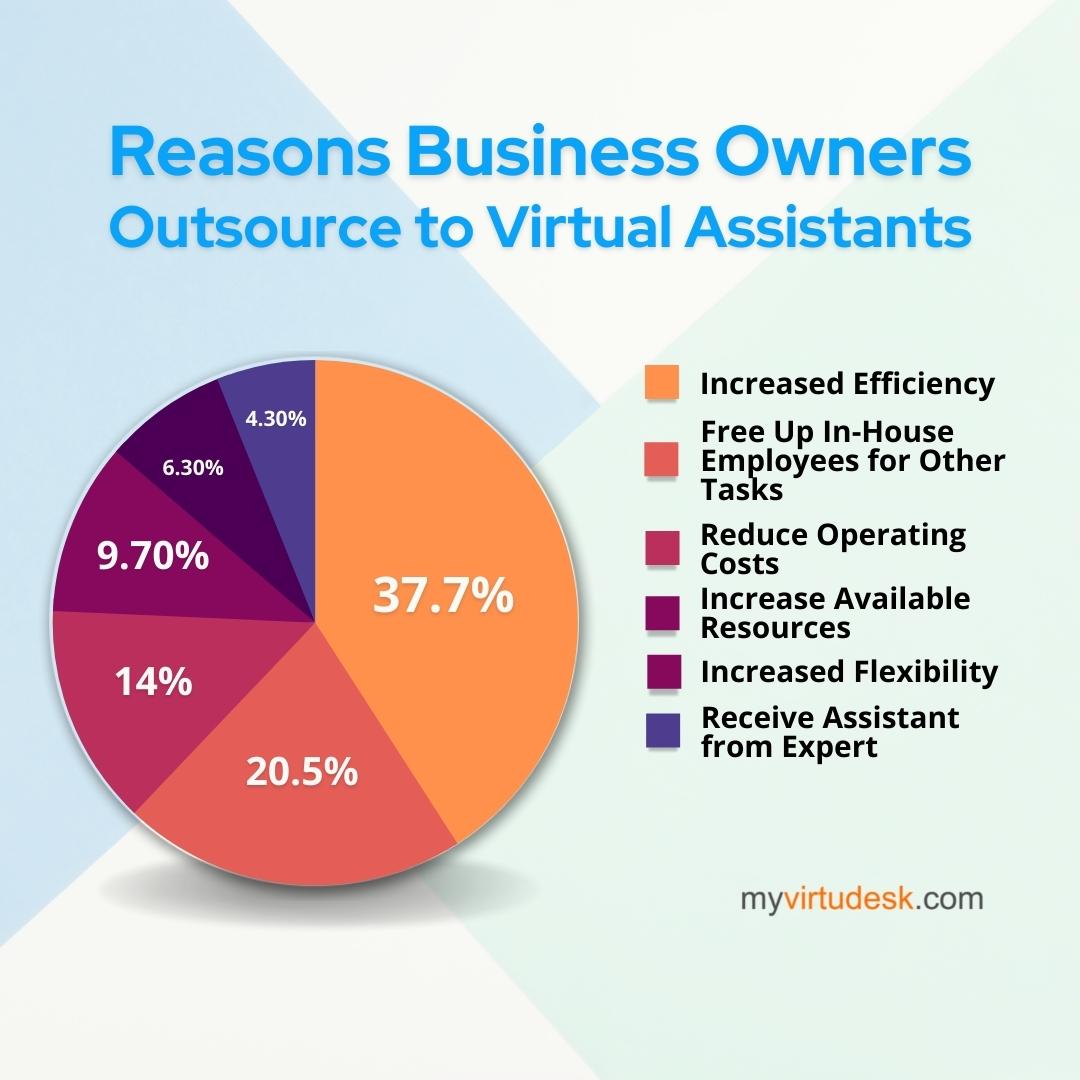
Cost Savings and Business Impact
- Businesses report an average cost savings of 52% by hiring a VA instead of a full-time employee in 2025.
- In 2025, the typical U.S. company saves approximately $56,300/year per VA in operational overhead.
- 71% of startups cite VAs as a “critical cost-saving measure” in their early-stage growth plans for 2025.
- 39% of businesses reported expanding output without increasing headcount due to VAs in 2025.
- Outsourcing to VAs reduced onboarding time by 43% compared to in-office hires, as reported in 2025.
- Companies using VAs cut their HR processing costs by 27% on average in 2025.
- Customer service teams using VAs saw a 32% reduction in ticket handling time by Q2 of 2025.
- A survey in 2025 found that 64% of CFOs plan to increase VA usage to offset rising labor costs.
- Recruitment agencies report a 47% drop in demand for in-house admin roles, replaced with VA contracts in 2025.
- Businesses using at least two VAs saved an average of $104,000/year in 2025, showing the compounding ROI impact.
Virtual Assistant Productivity and Efficiency
- In 2025, businesses using virtual assistants report a 28% increase in team productivity on average.
- 43% of managers say VAs helped reduce their weekly workload by 10 hours or more in 2025.
- The average task turnaround time by a VA is 17.6 hours, compared to 28+ hours for in-house admin teams.
- 88% of businesses using time-tracking tools report “high task efficiency” scores for VAs in 2025.
- Calendar management, inbox triage, and data entry remain the top three tasks VAs complete most efficiently in 2025.
- CRM data hygiene has improved by 34% among companies using VAs for client records and updates in 2025.
- Digital SOPs (Standard Operating Procedures) created by VAs increased by 22%, contributing to cross-functional clarity in 2025.
- Companies that paired VAs with AI tools like Zapier or ClickUp report a 35% boost in automation-driven output in 2025.
- Feedback loops between employers and VAs have improved, with 71% of managers saying VAs regularly exceed performance benchmarks in 2025.
- Virtual assistant onboarding times have decreased by 19%, thanks to better training workflows and cloud-based documentation.
Industries Hiring the Most Virtual Assistants
- 28% of virtual assistants are hired by entrepreneurs, the largest hiring group tapping into VA support for scaling and flexibility.
- 14% come from consulting firms, showing a growing demand for task delegation in strategic advisory roles.
- 9% are hired by coaches, leveraging VAs for scheduling, client support, and content delivery.
- 8% work in marketing, helping with campaign management, content creation, and digital outreach.
- 7% support the technology sector, including roles in customer support and tech documentation.
- 6% are employed in education, assisting with admin work, online course support, and student communications.
- 5% are hired in real estate, handling lead generation, CRM management, and appointment setting.
- 4% work in legal services, offering admin and document prep help to legal professionals.
- 19% fall under other industries, showing the broad and versatile appeal of VAs across sectors.
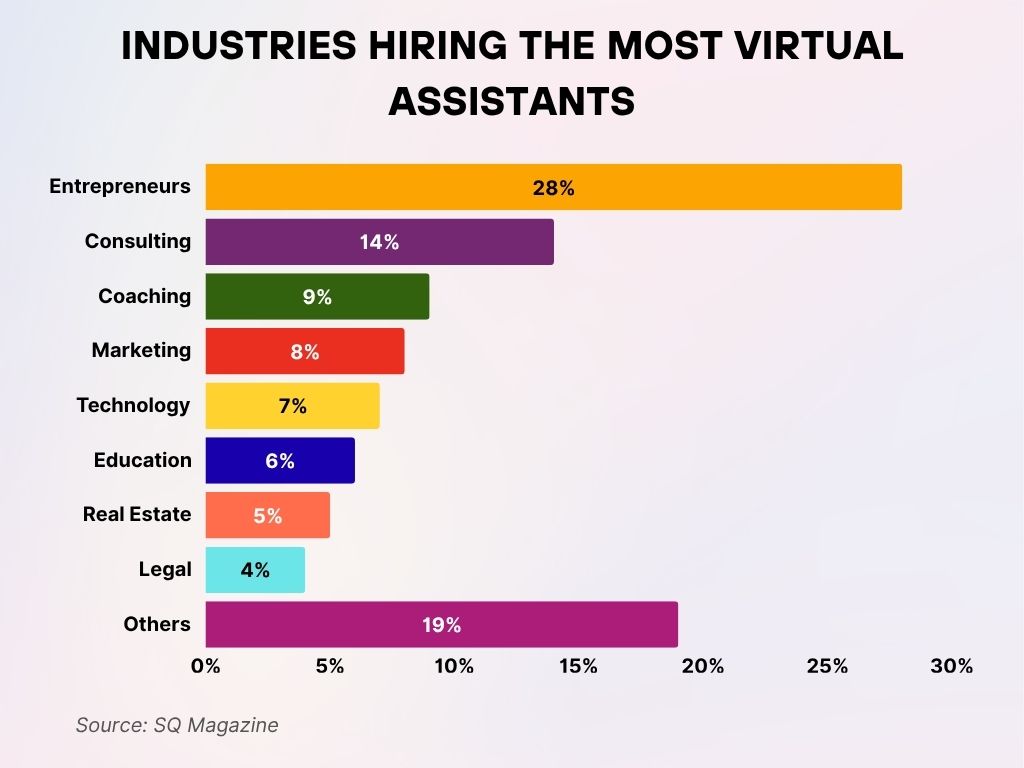
Specialized Skills and Service Areas
- In 2025, tech-savvy VAs are in the highest demand, particularly those skilled in automation, AI tools, and CRM platforms.
- Digital marketing is the most requested specialty, with 48% of businesses outsourcing SEO, email, and funnel tasks to VAs.
- Bookkeeping and finance-related VAs saw a 21% rise in demand in 2025, especially among small business owners.
- Podcast editing, video content prep, and YouTube management are now offered by 16% of all VAs globally in 2025.
- VAs offering e-commerce services (e.g., listing management, order tracking) now represent 29% of the industry in 2025.
- Project management VAs, trained in platforms like ClickUp and Notion, grew by 17% this year.
- AI prompt engineering has become an emerging niche, now offered by 9% of VAs in 2025.
- Content scheduling and engagement across social platforms are managed by 38% of VAs, especially in influencer-led businesses.
- Legal VAs handling contract prep, document organization, and paralegal support now make up 6% of the market in 2025.
- In 2025, language-based VAs (translators, multilingual support) grew to 14%, especially in cross-border operations.
Major Hiring Regions and Global Hubs
- The Philippines continues to dominate as the top VA hub in 2025, accounting for 23% of the global virtual assistant workforce.
- India follows closely with 17%, particularly strong in tech support and administrative services in 2025.
- United States-based VAs now represent 11% of the global market, largely focused on executive and creative support in 2025.
- Eastern Europe, led by countries like Ukraine and Poland, saw a 14% increase in VA hires due to strong multilingual skills in 2025.
- In 2025, South Africa emerged as a rising VA region, hosting 4.2% of global virtual assistants.
- Latin America, particularly Colombia, Brazil, and Argentina, collectively account for 9% of the VA market in 2025.
- Remote hiring from digital nomad hotspots like Bali and Chiang Mai grew by 32% in 2025.
- Australia and New Zealand make up 3% of the global VA market, typically offering high-tier, high-cost services in 2025.
- Canada has seen a 13% year-over-year growth in VA employment, driven by startup and nonprofit demand in 2025.
- Cross-border hiring is at an all-time high, with 76% of companies in 2025 sourcing VAs from outside their home country.
Virtual Assistant Market Growth Forecast
- The virtual assistant market is projected to grow from $6.37 billion in 2024 to $8.17 billion in 2025.
- The market is expected to expand at a CAGR of 24.6%, signaling rapid industry acceleration.
- By 2029, the market size is forecasted to reach $19.66 billion, more than tripling within five years.
- The consistent year-over-year growth reflects increasing global demand for virtual workforce solutions.
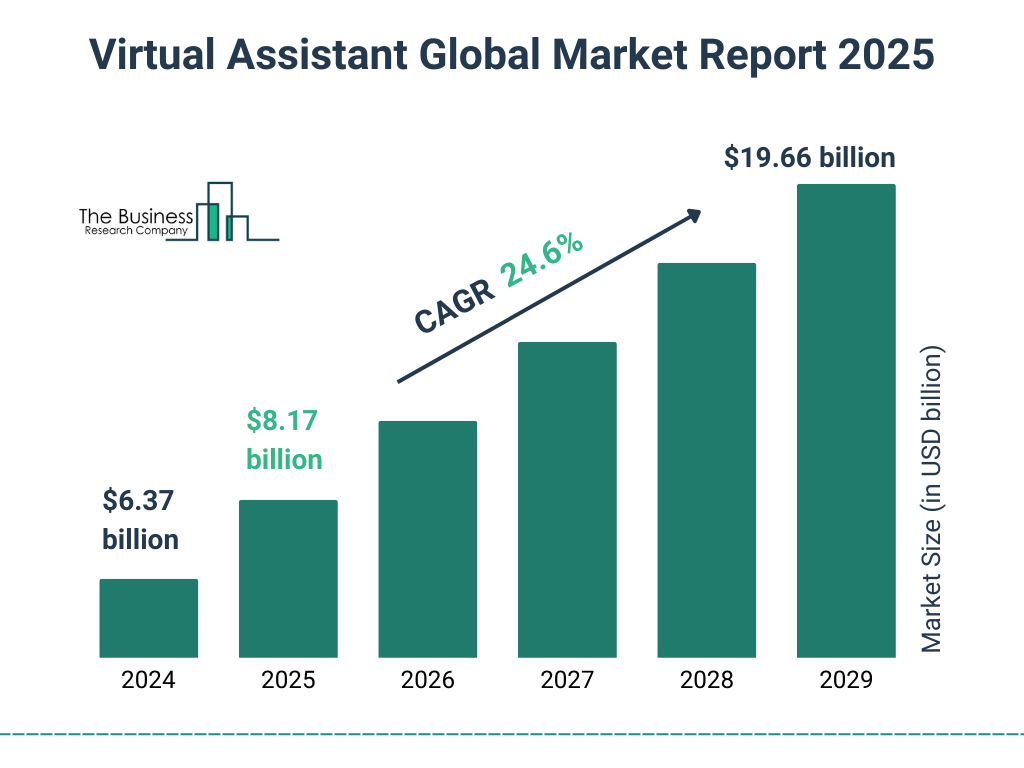
Sector-Specific Adoption (e.g., Healthcare, E-commerce)
- E-commerce brands are the top users of VAs in 2025, with 64% relying on them for order fulfillment, returns, and chat support.
- Healthcare providers, including private practices and telehealth clinics, now employ VAs for patient coordination in 29% of cases.
- In the legal industry, 26% of solo practitioners and small firms use VAs for documentation and scheduling in 2025.
- Real estate agencies using VAs for lead generation and listing management hit 39% in 2025.
- The coaching and online education sector reports 48% VA adoption for back-end course management and client support in 2025.
- Digital agencies (SEO, marketing, design) employ VAs for repetitive admin work in 57% of cases in 2025.
- Tech startups show the highest VA penetration at 72%, often using them from launch for lean scaling in 2025.
- Finance and accounting firms reported a 22% rise in using VAs for bookkeeping and tax prep assistance in 2025.
- Nonprofit organizations saw an uptick, with 18% using virtual assistants to handle donor communications and data management in 2025.
Technology and AI in Virtual Assistance
- In 2025, 36% of VAs integrate AI tools such as ChatGPT, Notion AI, or Jasper into their daily workflows.
- VAs using automation platforms like Zapier, Make (Integromat), or Pabbly increased productivity by 42% on average.
- AI-assisted transcription, scheduling, and inbox sorting are now used by 48% of tech-enabled VAs in 2025.
- Virtual assistant bots, powered by conversational AI, are supplementing human VAs in 19% of companies as of 2025.
- Cybersecurity tools have been adopted by 74% of VAs, driven by client data handling concerns in 2025.
- VAs trained in prompt engineering report a 24% earnings boost due to advanced AI optimization skills in 2025.
- Voice-to-text productivity tools like Otter and Loom are used by 51% of VAs globally in 2025.
- AI-assisted client reports and project summaries are now generated by VAs in 33% of marketing and finance roles in 2025.
- No-code platforms enable 18% of VAs to build custom dashboards, automations, or forms in 2025.
Marital Status of Virtual Assistants
- 45% of virtual assistants are married, representing the largest demographic group in the VA community.
- 41% are single, showing a nearly equal share of independent professionals in the industry.
- 7% are widowed or divorced, reflecting a smaller segment with prior marital experience.
- 5% prefer not to disclose their marital status, highlighting a portion valuing privacy.
- 2% fall under unspecified categories, possibly due to missing or non-standard responses.
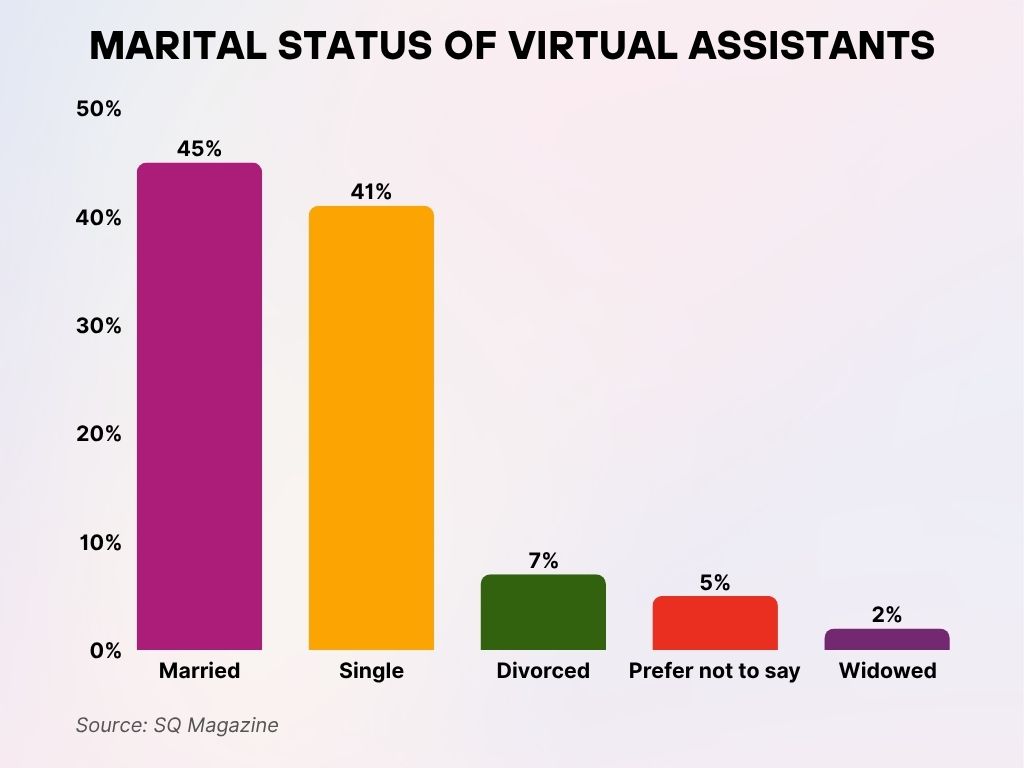
Challenges and Opportunities in the VA Industry
- Time zone coordination remains the top challenge, cited by 47% of hiring managers in 2025.
- Burnout and overcommitment are common among VAs, with 29% reporting weekly stress due to multitasking in 2025.
- Client onboarding misalignment is still an issue; 35% of VAs say they often lack clear instructions when starting new roles.
- Payment delays are reported by 18% of VAs in 2025, especially in freelance marketplaces with limited dispute resolution.
- AI automation tools, while boosting efficiency, are seen by 21% of VAs as a threat to certain low-skill task categories.
- Upskilling programs represent a major opportunity, as 62% of VAs enrolled in at least one training course in 2025.
- Micro-agency formation is on the rise, with 16% of experienced VAs in 2025 hiring subcontractors to scale operations.
- Language fluency and cultural nuance are seen as key differentiators by 49% of cross-border clients in 2025.
- Virtual assistant coaching businesses have grown by 37%, targeting those entering the space in 2025.
- Regulatory frameworks are evolving, with 5 new countries proposing formal labor guidelines for remote VAs in 2025.
Notable Usage Statistics and Insights
- In 2025, 72% of VA-client relationships last 6+ months, indicating high satisfaction and repeat engagement.
- 48% of clients who hire a VA end up hiring a second VA within 8 months in 2025.
- The average client rating for VAs on major platforms stands at 4.82/5 in 2025, reflecting quality service.
- Customer service, admin support, and content marketing are the most frequently reviewed service categories in 2025.
- A growing trend in 2025: co-managed VAs, where two businesses share a single assistant to reduce costs and time gaps.
- Virtual onboarding kits (templates, SOPs, tools) are used in 53% of VA hires in 2025 to shorten ramp-up time.
- Referral hiring now accounts for 31% of all VA-client connections in 2025.
- VAs report managing an average of 3.4 clients concurrently in 2025, maintaining portfolio diversification.
- Cross-functional VAs, those offering multiple services like admin + content, are hired 65% more often than single-specialty VAs in 2025.
Years of Experience Among Virtual Assistants
- 23.3% of VAs have 0–3 months of experience, showing a strong influx of newcomers to the industry.
- 18.2% have 1–2 years of experience, indicating a solid foundation of developing professionals.
- 14.2% fall in the 3–6 months range, representing early-stage but committed VAs.
- 11.1% each have experience spanning 6–12 months, 2–3 years, and >6 years, reflecting a mix of growing and seasoned professionals.
- 7.1% have 3–4 years of experience, adding depth to the mid-career segment.
- 5.1% fall into the 4–5 years experience bracket.
- 0.7% have 5–6 years, the smallest group in the dataset, showing rarity in that tenure window.

Industry Trends and Future Outlook
- AI-Virtual Assistant hybrid roles are expected to grow by 41% over the next two years, driven by tool mastery.
- Voice-based VAs (especially multilingual) will expand as global voice commerce scales in 2025 and beyond.
- Virtual assistant agencies are shifting to subscription-based pricing, now adopted by 38% of providers in 2025.
- Sustainability-focused brands increasingly prefer VAs to reduce carbon footprints tied to office-based roles in 2025.
- Blockchain-backed time tracking tools are starting to gain ground, piloted by 4% of VA platforms in 2025.
- Mental health awareness in the VA space is rising, with 28% of VAs now accessing peer support or wellness groups.
- Soft skills like communication, initiative, and emotional intelligence are now key hiring criteria for 79% of managers in 2025.
- The blurring line between freelancers, contractors, and digital employees suggests new employment models will emerge post-2025.
Conclusion
The rise of virtual assistants in 2025 signals more than a workplace evolution; it’s a definitive shift in how businesses scale, operate, and support their teams. From solopreneurs looking to reclaim their time to enterprises embracing lean, remote-first structures, VAs are no longer a niche solution. They are a strategic asset. With technology advancing, costs stabilizing, and services diversifying, the virtual assistant landscape is poised to become even more essential in the years ahead.



